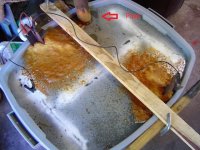tmajor
Platinum Member
- Joined
- Oct 9, 2007
- Messages
- 704
- Location
- NE PA
- Tractor
- 2010 MF 1529, Woods ZTR MZ1952, National Mower sickle bar circa 1963
There is one aspect of my project, which i don't understand. I started with a 2" black pipe for the anode. While it worked, it didn't seem to be as effective as anodes of angle iron. At one point, I had the pipe and 2 angle irons in the bath and the pipe drew very little rust, as compared to the angle iron anodes. ??

The anodes can be cleaned off and reused.

The anodes can be cleaned off and reused.